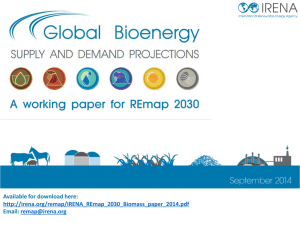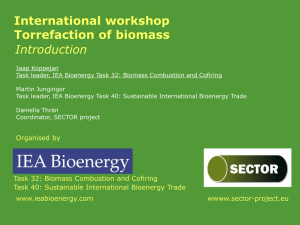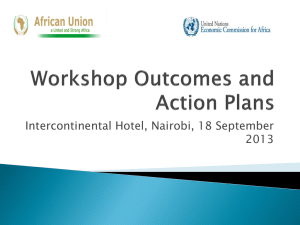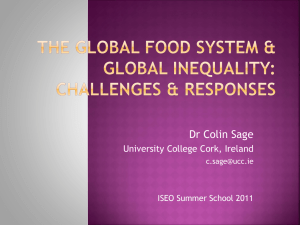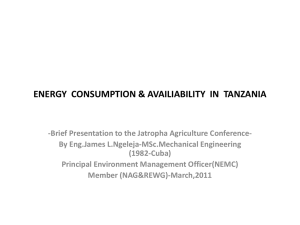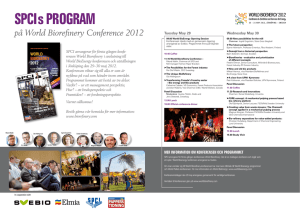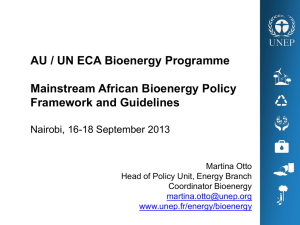Assessing Bioenergy Potentials in Rural Landscapes
advertisement
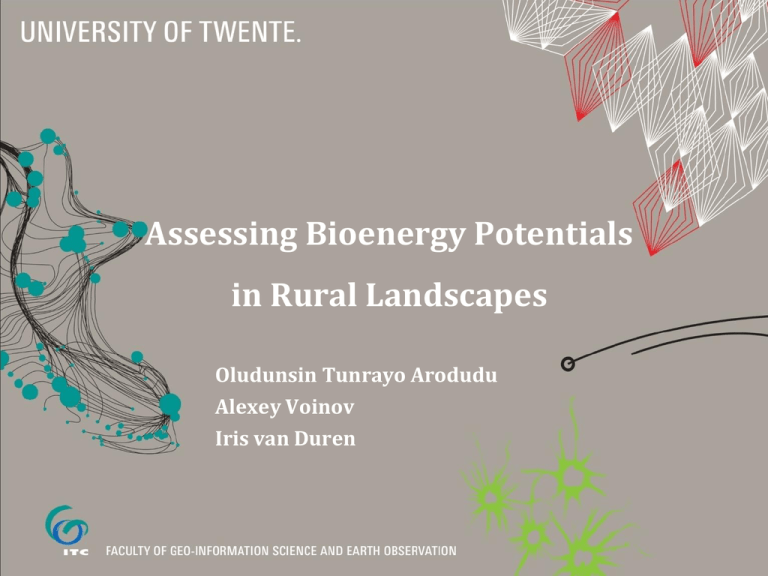
Assessing Bioenergy Potentials in Rural Landscapes Oludunsin Tunrayo Arodudu Alexey Voinov Iris van Duren INTRODUCTION Climate change challenges Shortage of fossil fuel supply Depletion of global fossil fuel reserves Research Problem Developing a more holistic approach for assessing bioenergy potential under an SEA framework Known measures of bioenergy potential Available land Some biomass are not grown on land Biomass yield Not a function of energy obtainable Energy yield Energy invested not considered Money invested and gained Susceptible to political and market mechanisms ALTERNATIVE APPROACH:NEG/EROEI Net Energy Gain (NEG) NEG = Energy Output - Energy Input Net Energy Gain becomes a loss when it is less than 0 & Energy Return on Energy Invested (EROEI) EROEI = Energy Output / Energy Input Energy production activity becomes incapable of supporting continuous socio-economic function when EROEI is less than 3 SCOPE OF THE STUDY (RURAL LANDSCAPES) Crop residues Farm manure Natural grasslands WHY? Surplus pasturelands Relative benignity and favourability in terms of existing policy constraints: Food security Nature conservation: soil, water, biodiversity Competitive use of biomass and well being of the local people Reasons for choice of crop and animal For crops (Scarlat et al, 2010): Corn, Rye, Triticale, Wheat, Barley, Oat, Rapeseed • Availability in commercial quantity • Good Crop to Residue Yield For animal (Fehrs, 2000): Beef Cattle, Dairy cattle, Pig, Chicken • large Population of animal • % collectable on barns and hard surfaces For Grasses on Surplus pasturelands (Prochnow et al, 2009)- Alfalfa • Prevent a total change in ecosystem structure • Meet future fodder needs Factors influencing potential availability of biomass for bioenergy production For Crop residue (Scarlat et al, 2010) • Use for soil conservation purposes • Use as substrates for mushroom (Wheat) • Use for animal beddings For Animal waste (Fehrs, 2000) • % collectable on barns and hard surfaces For Grasses (van Vuuren et al, 2010) • Use for animal beddings and animal feed Method: Combination of Life Cycle Inventory (LCI) and GIS From the LCI: •List of energy inputs and outputs, biomass and energy conversion models and coefficients •Estimation of Potential Biomass and Biomass Potentially available for Bioenergy Production •Estimation of Energy Input and Output of the different bioenergy production options •Estimation of NEG and EROEI of the different bioenergy production options From the GIS: • Estimation of area under natural grassland using GIS coverages (LGN 6 Land cover map) RESULTS: PERCENTAGE COMPOSITION Biomass type Percentage (%) Manure 89.56 Crop residue 9.99 Natural Grassland 0.44 Surplus pasturelands 0.01 Manure by far has the largest biomass and bioenergy potential RESULTS: FARM MANURE Large NEG, not necessarily high EROEI RESULT: CROP RESIDUE Biomass type Corn NEG (TJ) EROEI 6684.78 16.68 Rye 6.93 9.23 Triticale 7.75 8.52 Wheat 44.80 9.59 1.42 7.91 33.96 8.96 2.55 9.04 Oat Barley Rapeseed Corn residues: • most energy efficient : High EROEI • most energy profitable: High NEG Results: Choice of grass harvest for bioenergy production Biomass type NEG (TJ) EROEI Natural Grassland: Early Harvest (< 12cm) 153-256 7.44 Intermediate Harvest (15-20cm) 216-361 11.62 Late Harvest (>25cm) 136-228 13.09 Early Harvest (< 12cm) 2.47 2.12 Intermediate Harvest (15-20cm) 4.71 4.09 3.34 7.06 Surplus Pasturelands: Late Harvest (>25cm) Natural grassland (Intermediate Harvest): Natural Grassland Management Policy in the Netherlands Surplus Pasturelands (Late Harvest): Highest energy efficiency value (EROEI). Comparison of EROEI levels Evaluation of Overijssel’s bioenergy potential Form of energy Bioenergy Conversion Bioenergy Net Gain target Efficiency potential to EU (60PJ) of biogas NEG-66PJ targets elsewhere Transport fuel 23PJ 96% 23PJ - Heat (CHP) 13PJ 70% 28PJ +15PJ of heat Electricity (CHP) 14PJ 35% 14PJ - 5.94PJ -3.06PJ Industrial 10PJ As liquid raw fertilizer material Extra 2PJ of biogas still exists. Conclusions • NEG/EROEI approach is quite holistic: Opens up room for broad analysis of bioenergy potential issues • Alternatives: minimizing constraints and maximizing energy gains Unconventional biomass sources Farm scale wet anaerobic co-digestion technology Better animal management options and farm structures • Energy efficiency component: EROEI • Accurate evaluation of bioenergy targets: NEG • Basis for stakeholder interactions Thank you!!!



